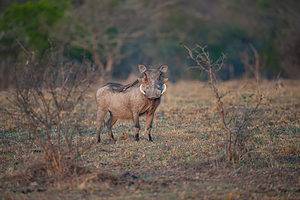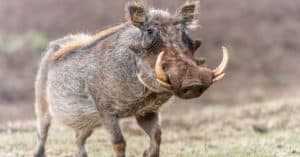Many animals in the ocean look and act alike, even if they are not too closely related. The porpoise and beluga whale are two such creatures that, depending on species, can look very similar or different enough that you can tell them apart at a glance. To aid you with differentiating these sea mammals, we’re going to compare the porpoise vs beluga whale.
By the time we’ve finished, you’ll know where each creature lives, how to tell it apart by size, and other interesting qualities they possess!
Comparing a Porpoise and a Beluga
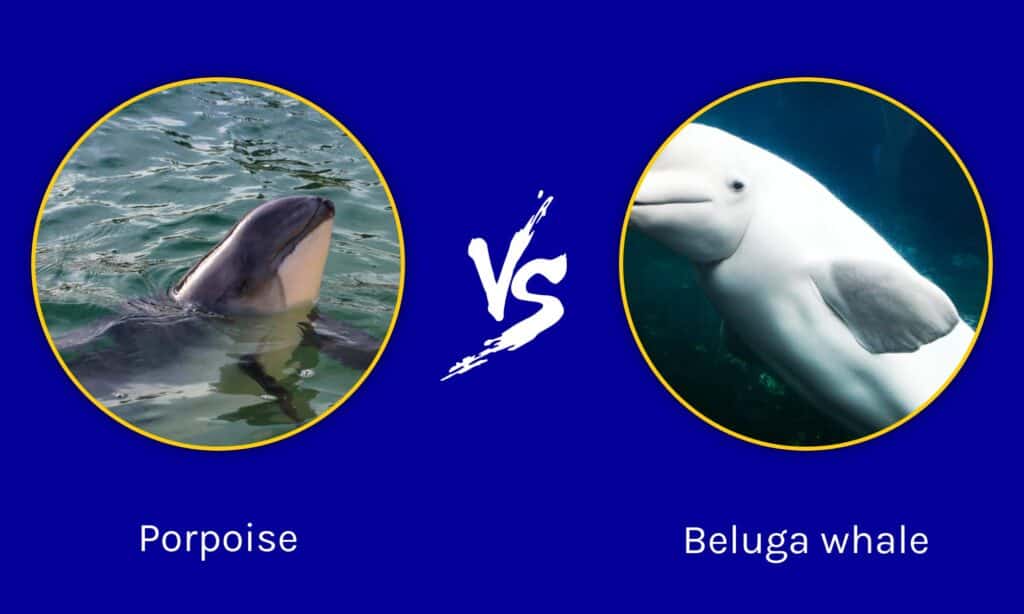
| Porpoise | Beluga | |
|---|---|---|
| Size | Weight: 100-500 lbs Length: 4.5-7.7 ft | Weight: 1,500-3,500 lbs Length: 11-18 ft |
| Morphology | – Has a somewhat bulbous head, depending on species – Curved snout – Can have a dorsal fin or be finless – Thick body in gray, dark gray, black, white, typically in combinations | – Large, bulbous head due to the prominence of its “melon”, the echolocation organ – Curved Snout – Usually, dark gray or bluish when first born, but turn white or white-gray with age – Rounded body – Unfused vertebrae allow the creature to turn its head – No dorsal fins |
| Range | – Northern hemisphere – Lives in North Atlantic and North Pacific Oceans – Depending on the species, can be found in the Arctic Ocean – Can be found as far south as Japan, California, and Morocco – Often live in small pods of 2-4 creatures | – The Arctic Ocean and some sub-Arctic areas, like the Bering Sea – Typically live in large pods – Males may travel together, but females and juveniles travel separately |
| Habitat | – Found in coastal waters – Prefer harbors, bays, estuaries, and more | – Often found in shallow coastal waters – May spend extended periods in the deep ocean |
| Scientific Classification | – Phocoenidae genus – Seven species | – Delphinapterus leucas – Specific creature |
The 5 Key Differences Between a Porpoise vs Beluga
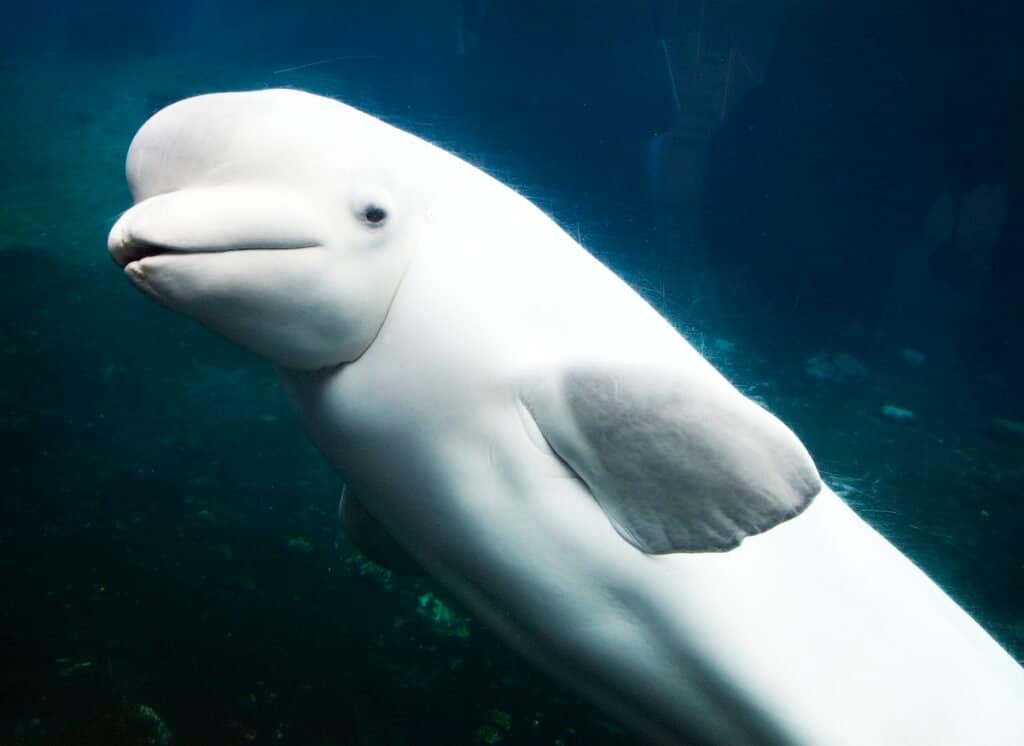
Beluga whales are pure while and look like they have shoulders.
©Carol M Highsmith / CC0 1.0, Rawpixel – License
The biggest differences between a porpoise and a beluga whale are their size, morphology, and range. Beluga whales are much larger than porpoises, weighing up to 3,500 lbs and measuring 18 ft long while the porpoise only weighs between 100 and 500 lbs and measures 7.7 ft long.
Beluga whales are white as adults, and they have a large protuberance in their bulbous heads. They also possess the ability to turn their necks. While some porpoises have white in their coloring, they are never pure white, they cannot turn their heads easily like dolphins, and they have a somewhat bulbous head but to a far lesser extent than the beluga whale.
Moreover, beluga whales have a smaller range than the porpoise, and they are only found in the Arctic Ocean and sub-Artic regions. However, porpoises are found in the Atlantic, Pacific, and Arctic oceans.
With all these unique qualities in mind, it’s time to look even closer at these differences to hammer home the concept that they’re unique creatures.
Porpoise vs Beluga: Size
The beluga whale is much larger than a porpoise. The average porpoise grows about 7.7 ft long and weighs between 100 and 500 lbs. However, the beluga measures up to 18 ft long and weighs between 1,500 and 3,500 lbs. Performing a quick size comparison is an easy way to tell these animals apart.
Porpoise vs Beluga: Morphology

The beluga whale has a very large protuberance in its head.
©CampCrazy Photography/Shutterstock.com
A porpoise and a beluga can look similar in some circumstances. Let’s look at the differences first, though. A porpoise tends to have a somewhat bulbous head and a curved snout. It may or may not have a dorsal fin, depending on the species.
Their colors include gray, dark gray, light gray, black, and white. However, you’ll usually see black and white together on the mammal and other combinations of grays.
When they are first born, beluga whales can be gray or even bluish in color. Yet, they turn completely white as they age, something you probably will never see in a porpoise. Furthermore, they can have a yellow tinge to them as they age.
The beluga is known for its rounded, bulbous head that is much larger than a porpoise’s head. This part of their body houses their echolocation organ, called a “melon.” These creatures have a rounded body instead of a somewhat dolphin-like body as the porpoise possesses.
Lastly, belugas have unfused vertebrae, so they can easily turn their heads. Meanwhile, the porpoise has a stiffer neck, and it cannot turn its head side to side very well.
Telling a porpoise from a beluga whale is easily managed by looking at the presence or absence of dorsal fins, colors, and the appearance of “shoulders” on a beluga whale.
Porpoise vs Beluga: Range
The porpoise lives in many places including the northern Atlantic and Pacific oceans. Some species do live in the Arctic Ocean, but they can be found as far south around the world as Japan, California in the U.S., and Morocco. These animals live in small pods of 2 to 4 creatures, and they tend to be shy.
The beluga whale lives in the Arctic Ocean and some sub-arctic areas. They travel southward to areas like the Bering Sea, but they do not travel nearly as far south as porpoises. These animals tend to live in large pods with males and females traveling separately in some cases.
Porpoise vs Beluga: Habitat
Both porpoises and belugas are found in coastal waters. Porpoises are often seen in harbors, bays, estuaries, and other areas. Yet, the beluga whale splits time between coastal areas where it’s often spotted and deeper ocean waters where they spend extended periods of time.
You have a far better chance of seeing a beluga out at sea than a porpoise, as long as you are in the Arctic Ocean.
Porpoise vs Beluga: Scientific Classification
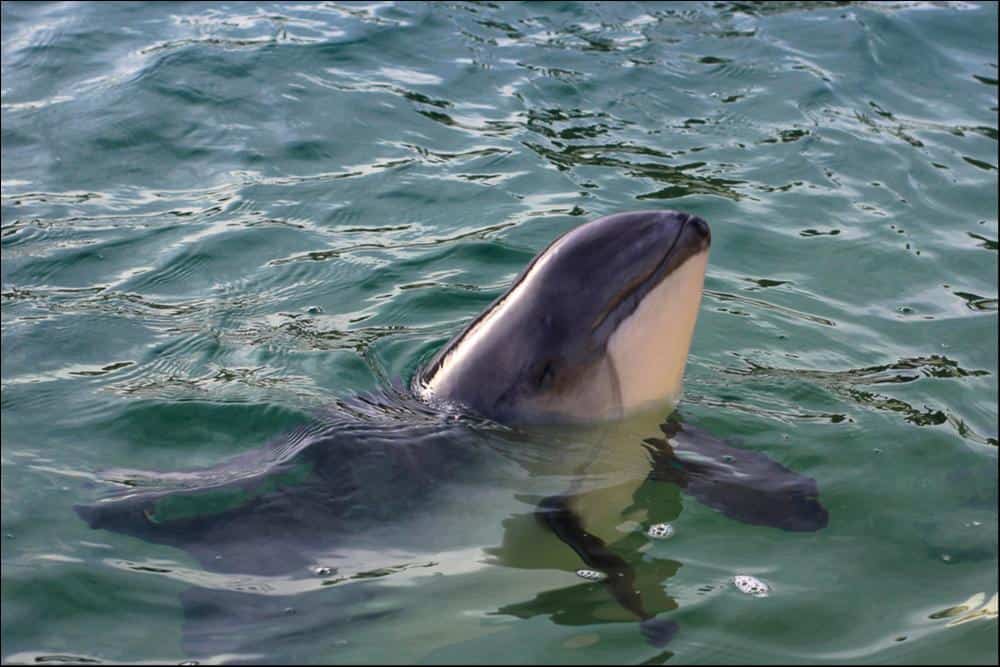
Seven species of porpoise exist.
©Elise V/Shutterstock.com
The porpoise is a member of the Phocoenidae genus. There are seven different species of this creature. The beluga whale’s designation is Delphinapterus leucas, and this refers to this one specific creature.
In short, many types of porpoises exist, but there is only one beluga whale. Interestingly, some of them, like the Indo-Pacific finless porpoise, can closely resemble some traits of the beluga.
All in all, though, these are two very unique animals. The porpoise is very dolphin-like, and the beluga whale is more like a mix between a true whale and a dolphin in terms of size and behaviors. Knowing these major differences, it should be simple to tell these animals apart from one another.
The photo featured at the top of this post is © Pavaphon Supanantananont/Shutterstock.com
Thank you for reading! Have some feedback for us? Contact the AZ Animals editorial team.



